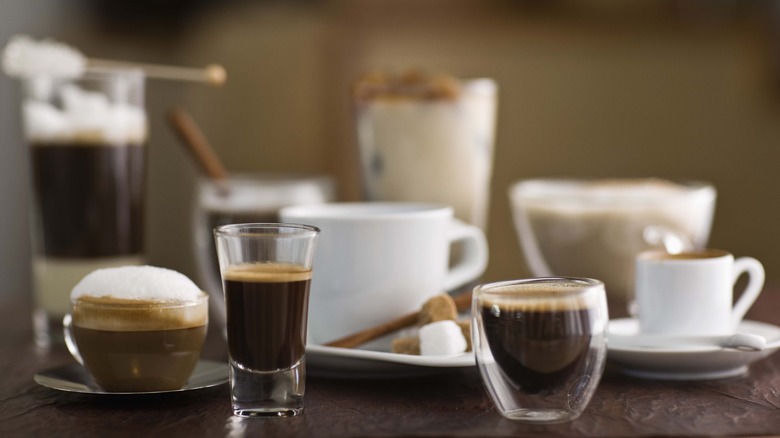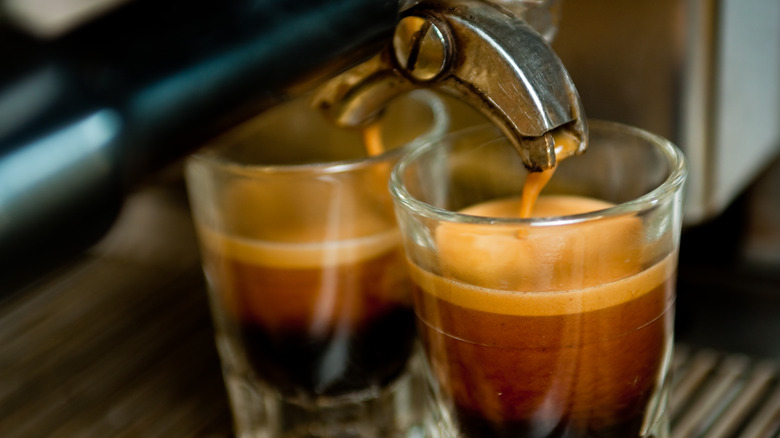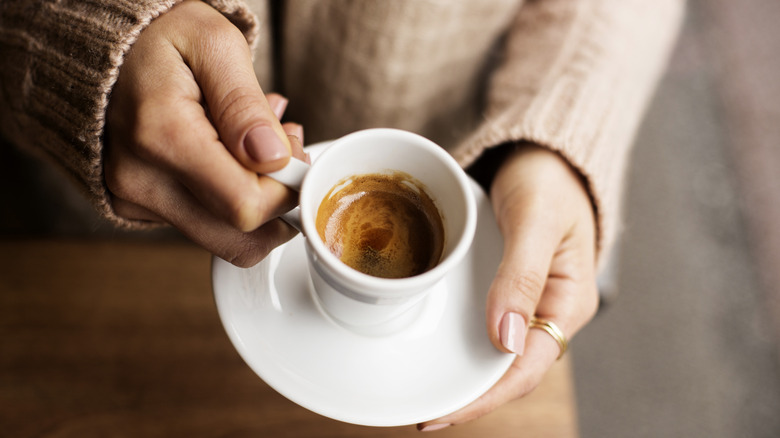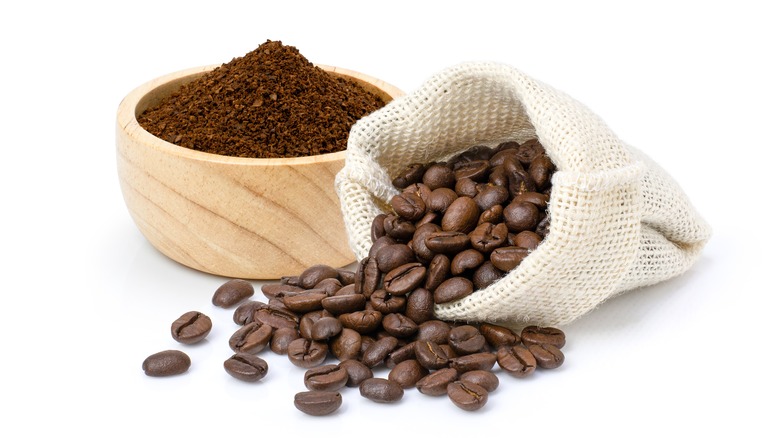What Exactly Is The Difference Between Coffee And Espresso?
When you walk into pretty much any coffee shop on the planet, you're usually given a few ordering options on the menu — and two of the biggest, boldest, capital-letter ones are coffee and espresso. Therefore, it's only natural to wonder what the difference is between them. In the simplest terms, espresso is stronger, undergoes a different extraction process, and is a more concentrated type of coffee.
As espresso and coffee drinks are made with coffee beans that have been roasted and ground and are brewed using hot water, they start the same. The main difference — and certainly the most obvious to anyone drinking the stuff without any milk or sugar — is that espresso is a very intensely flavored coffee beverage. While a cup of drip coffee and an espresso might start with the same amount of ground coffee in the recipe, espresso is brewed with only about two ounces of water versus eight to 10 ounces, so it packs a big punch in the taste department. Espresso is also ground much finer than beans used for drip coffee.
Other differences between coffee and espresso
Another difference between espresso and more generic coffee is brew time. Coffee comes in various styles and preparations, each of which requires a different brewing time. An AeroPress, for instance, can make a very small amount of coffee in under two minutes, while a French press or a Chemex might take five minutes or more. Cold brew is a 12 to 24-hour situation, which may seem like a lifetime when you consider that the ideal espresso shot is fully extracted in under 30 seconds. The way this magic is achieved illustrates another key difference between coffee and espresso — pressure.
Just like the catchy bass line of the classic David Bowie and Freddie Mercury song, espresso gets its speed and its chutzpah from being brewed under pressure. While most drip coffees rely on gravity to do the slow, steady work of pulling water through coffee grounds, a well-tuned espresso machine uses mechanical pump pressure to force hot water through very fine coffee grounds, which creates the fine, tan layer of natural foam called crema.
Espresso machines were invented to perform this task very precisely, with an emphasis on speed and strength. The first espresso drinkers were Italians during the Industrial Revolution who needed a way to prepare their preferred style of coffee, more akin to a Middle Eastern or Turkish-style brew, quickly enough to shorten their coffee breaks and get back to work in the factories.
Does espresso have more caffeine than coffee?
Another confusing area for many is whether espresso has more "oomph," meaning more caffeine. Since caffeine is reliably soluble in hot water, a double shot of espresso contains a not-too-dissimilar amount of caffeine as your standard cup of Joe, between 96 to 128 milligrams. The difference is in the caffeine by volume, which all depends on serving size. A single ounce of espresso has approximately 63 milligrams of caffeine — and most espresso shots are served as doubles — while brewed coffee can range from eight up to 20 ounces. As coffee has between 12 to 16 milligrams of caffeine per ounce, 20 ounces of brewed coffee can have closer to 200 or more milligrams of caffeine, so take it easy on that stuff, pal.
However, the concentrated flavor of espresso allows it to shine through steamed milk in layered beverages like lattes. It's also what gives it a creamy texture that coats your tongue. On the contrary, it makes it a tough drink to nurse. No one is still sipping a double espresso shot two hours later, so if you intend to camp out with your laptop, I suggest ordering something a bit longer in the cup.
How roasting affects the flavor of coffee and espresso
While roast is not a defining characteristic of espresso versus coffee, many roasters approach coffees differently when developing them to be brewed as regular coffee or espresso. The nature of preparing espresso can make certain flavors overwhelming and even unpleasant in the cup. Bright fruit notes like citrus or lemon add a nice tang to a filter or press-brewed coffee. Conversely, in a highly-concentrated shot of espresso, those same notes might make your face implode, like sucking on a lemon rather than getting a minor hint of lemony flavor from zest.
While there are technical ways that a roaster can change his profile to be more "espresso friendly" (such as roasting the beans darker, or at a lower temperature for a longer time — both of which will temper the zingy flavors, lower the acidity, and bring out more chocolate, nut, and sweet tones), the truth of the matter is that you can use any roasted coffee to make espresso, because there are no rules to flavor. Plus, at the end of the day, coffee beans are coffee beans, and you can do whatever you want with them, no matter what their roast level or place of origin is.



